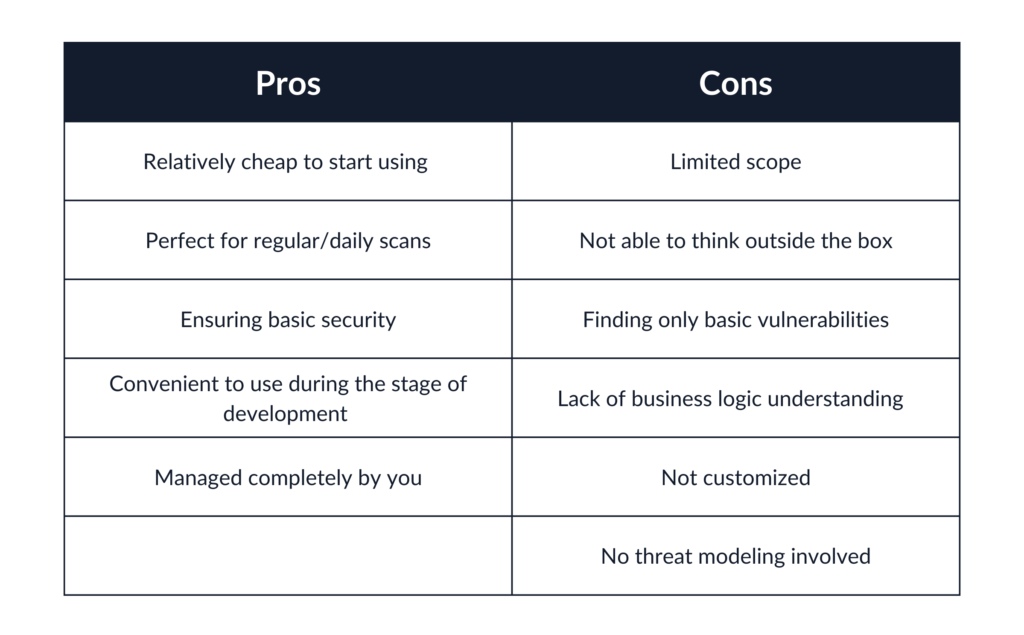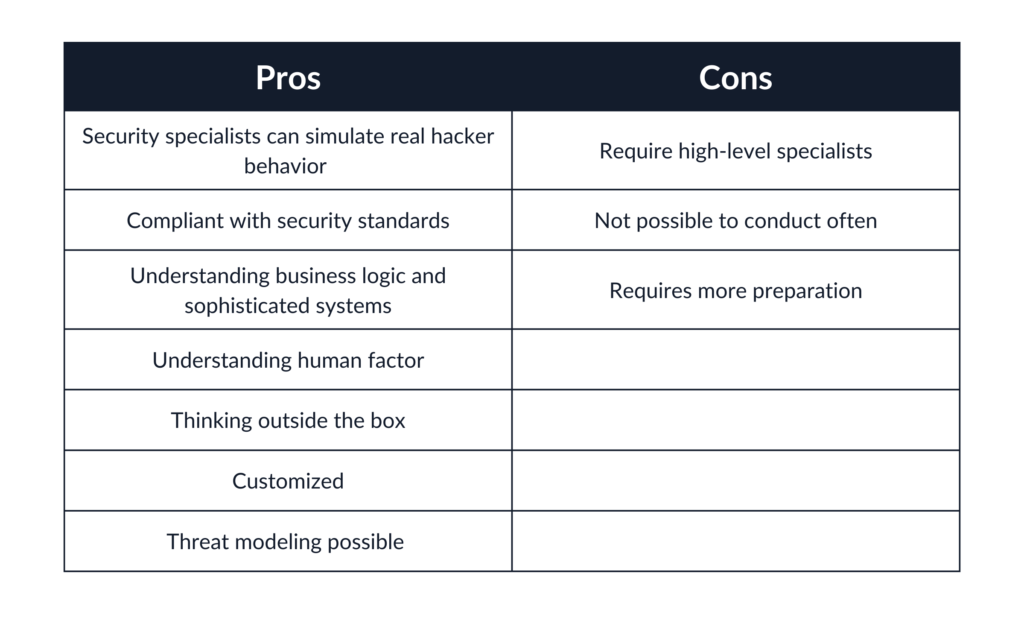Manual vs. automated penetration testing – or maybe both?
This article shows why manual and automated penetration tests are both important and not interchangeable. You will also find a list of pros and cons of two approaches that will help you make the right choice.

As technology becomes more advanced, hackers become more seasoned too. This is why, nowadays, ensuring the security of IT infrastructures and applications becomes more challenging and requires an increasing spectrum of action and protection. But… how? How to protect your system? There are plenty of options with various levels of effectiveness and diverse approaches – the most common of which is penetration testing – simulating hacking attacks under controlled conditions. Here, we also have two main methods – conducting such tests in a manual way or using automated tools.
But many questions still remain. What kind of a penetration test will be the best in my case? Can I use both approaches? How often should penetration testing be done? Well, the answers are pretty simple. Penetration testing should be a regular part of your daily routine if you are making software and operating user data. It is worth testing your organization security from different perspectives and using diverse approaches. It will reduce vulnerabilities and protect your company from unexpected attacks. Not only will people in your organization have the perception that you take security issues seriously, but there is also added value for your customers because it is their data that is in safe hands. If you are creating software for clients, regular pentests will increase the value of your product.

What is automated penetration testing?
Automated penetration testing is the process of scanning systems for vulnerabilities using automated penetration testing tools. It has gained popularity thanks to cost-effectiveness and convenience – your task is to buy a tool and launch it. Really simple. Automated pentests tend to be cheaper than manual ones and they obviously can come in handy. However, automated tools cannot cover all your security problems – manual tests definitely have a broader scope here.
Should I go for automated penetration testing?
As mentioned earlier, automated tools are quite common, but they will not solve all your security issues on their own. If you already own an automated tool – you do not need to throw it away, but just learn how to benefit from it.
Scope of automated tools
First of all, good tools do their job – and do it well! But their scope is limited and completely different from the scope of manual tests. They check only things they were programmed for – nothing more, while manual tests dig deeper.
Scanning security on a regular basis
However, you will never be able to constantly conduct manual tests – it would require impossible number of resources. And automated tests, on the contrary, will be great for checking things on an ongoing basis, reducing the risks from newly appeared vulnerabilities, and ensuring basic security. If you are using automated tools, it is good to keep them running all the time – this will save your time, money, and nerves.
Security on the stage of development
You should also consider using automated tools on the stage of development, since some developers have limited knowledge of cybersecurity threats and vulnerabilities – even those basic ones – and do not stick to security standards while creating software. So, the security processes in your organization should be controlled top-down to ensure that your software meets the best standards – and automated tests are the best choice here. They are simple in use and will cover all your primary needs, so that your systems do not come out with obvious vulnerabilities.

So, should you go for automated penetration testing? Yes, you should, but you should also be aware of their drawbacks and conduct manual tests on top of them.

What is manual penetration testing?
Manual penetration testing is the process when professional security experts manually evaluate the security of a system to find vulnerabilities, which may pose a threat to the said system and to data it stores. In this case, security specialists act as good “hackers”. They manually try to break into your system to show you what kind of vulnerabilities it may have. What is more, security experts usually prepare recommendations on how to improve the security of your systems based on their knowledge and experience.
Why is manual penetration testing important?
As automated tools may cover your basic needs in cybersecurity, they were not crafted to test every bit of a system and also have several drawbacks, which are covered by manual tests instead. So, if you have a solid approach to security, you should consider asking a team of security experts to conduct a pentest, apart from doing automated testing on your own.
“Hacker” approach
During manual penetration testing, a team of security experts acts as good “hackers” – which means that they use the same methods as bad hackers do but for good purposes and in controlled environment. This is the first thing that distinguishes manual testing from an automated one. Security experts can reproduce hacker way of thinking, while automated tools are only capable of checking for standard vulnerabilities and issues.
Compliant with security standards
Manual testing is also important if you want your system to be compliant with such standards as PCI DSS, DORA, etc. Manual tests are one of the requirements for your system to be compliant with the standards.
Best for custom solutions
Manual pentesting is adaptable to the diversity of IT systems and their implementation. This is especially important for application security testing. An automated scanner is often not even able to replicate a typical user operation on its own (e.g., a wire transfer in an online banking application) – such actions are too sophisticated for tools to analyze because they are composed of several unobvious elements. This is the reason you should use help of a security team – in contrast with automated tools, security experts are able to think outside the box, reflect on what was done, and ask proper questions to move forward.
Understanding business logic
Security experts are able to understand business logic of a system and automated tools are not – because they are not able to think on their own, the tools use pre-defined schemas – but vulnerabilities related to the logic are among the most common ones. Here, manual testing is especially useful, because pentesters will test nooks that are undetectable for scanners, they sometimes use their intuition and curiosity, which often lead to finding unexpected issues. Among vulnerabilities that automated tools do not cover but manual pentesters may find are, e.g., “blind SQL injection attacks, logic flaws, and access control vulnerabilities”1.
Threat modeling
What is more, you can rely on manual tests in terms of the proper threat modeling. Because, as for now, only humans can properly analyze potential attacks and risks that can come from hackers’ actions. Threat modeling also allows you to predict incidents and avoid them before putting your organization at risk – and sometimes this risk lies in human factor which cannot be fully understood by a tool.
However, it is also important to understand that, in the cybersecurity world, manual tests often come hand-in-hand with automated tools – but the tools that the specialists use are different from tools offered for non-cybersecurity companies to track their level of secutity. Usually, experts use tools created on their own in order to make some parts of their work more effective – e.g., searching large data sets, scanning, enumeration, etc. This allows to pay attention to those invisible and hard-to-find vulnerabilities and do the job properly.

Can I mix automated and manual tests?
We believe that security is a highly important component of every IT environment – either you create software or use sophisticated software as a part of your work in an organization. This is why you do not have to settle for one approach in security testing. Manual and automated tests are not interchangeable – each of them plays its role in the security of your company and you can benefit from both of them at once.
Summary
To sum up, we want to say – in order to keep your system as secure as possible – use automated tools (especially if already you own a licence for one) to check for vulnerabilities on a regular basis and combine them with manual tests from security experts. We believe that manual tests in general are more deep and effective but automated tests allow you to control changes that happen daily – not once or twice a year. Automated tests are useful for finding low hanging fruits, while manual tests will catch a mass of vulnerabilities too complex for automated scanners. Remember, nothing guarantees 100% safety but, by broadening the spectrum of your security practices, you significantly reduce your exposure to risks. Security is something that you should always take care of – and you will gain trust from your clients and reduce stress from unexpected “events”.



